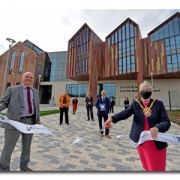The push to pump fresh air into schools
By John Lorinc
Indoor air quality was always low priority, but COVID-19 presents an important opportunity to build healthier schools
Indoor air quality, according to Jeffrey Siegel, a University of Toronto professor of civil engineering, has long been regarded as the poor cousin of the sustainable buildings movement. “It has always been this incredibly neglected piece,” he says, pointing to the green-building design world’s laser focus on energy efficiency and the importance of creating more airtight structures.
Siegel’s expertise is in healthy buildings, and he is cross-appointed to U of T’s public health faculty. He points out that ventilation systems, which consume a lot of energy, tend to be neglected, particularly in institutional buildings, like schools.
But the COVID-19 pandemic has flipped this story on its head, especially when children, teens and teachers began venturing back into schools in the fall. Suddenly, robust ventilation systems that bring fresh air into schools are regarded as a critical defence – along with masks and social distancing – against the airborne transmission of the coronavirus.
The question, of course, is how to improve those systems. In most public boards, the portfolio of schools is extremely diverse, in size, shape, upkeep, age, traffic levels and so on. Some are newer and well designed, and others are old and neglected. For many institutions, air quality was low on the list of capital priorities pre-COVID. What’s more, adequate ventilation depends on many factors, from whether the windows open to the custodian’s skills in maintaining the mechanical systems. “The right answer,” says Siegel, “is ventilating better, not ventilating more.”
The most straightforward way to heed that advice is to change some basic operational practices. At Canada’s largest public board, for example, facilities officials have come up with a series of practical moves to boost the circulation of fresh air: starting exhaust fans two hours before school and running them for longer after the kids leave, as well as cleaning and replacing filters and air-supply grates more frequently. “If mechanical ventilation is not available,” says Toronto District School Board spokesperson Ryan Bird, “[we will] open windows to provide outdoor air.”
Tye Farrow, a Toronto architect who specializes in healthy buildings, has recommended a more aggressive set of fixes to his school clients, which tend to be independent academies. Several of the changes are based on the measures hospitals use to contain airborne disease transmission. These include installing ultraviolet-C lighting, a disinfectant, and MERV-13 filters; accelerating the circulation of fresh air; and employing what Farrow describes as the “submarine” approach to indoor space – that is, segmenting buildings into “bubbles” to limit the spread of the virus.
He also has urged school clients to invest in so-called bipolar ionization systems, which are magnetic devices installed in the HVAC system. They add a small charge to air passing through the ducts. The charge, he explains, causes microscopic particles to bind to larger airborne particles that will, in turn, be trapped by the MERV-13 filters. “We’ve advised all our clients to put it in their systems,” he says, adding that many began planning mitigation measures in the spring.
Many other building owners have taken similar steps. Property management firms for months have been making significant investments in heavy-duty air filters and the ionization systems for clients that range from office building landlords to movie theatre operators, according to a July report from Bloomberg, which noted that HVAC giants like Honeywell and Carrier have seen a surge in demand.
Yet Siegel is skeptical about some manufacturers’ claims about the virus-catching and -killing properties of these devices. “[Bipolar ionization] has been available for decades,” he says. “Why are there no independent high-quality journal articles on them? A reasonable guess is that the manufacturers don’t want to pay for this research because they already know the answer – they don’t really work.”
Farrow, however, adds another layer: when he’s checked in with school clients that have taken steps to improve ventilation, they tell him the students and staff seem relaxed and happy to be back, amidst the more general sense of unease in the public system. While private schools clearly have more resources to invest in altering the indoor environment, Farrow points out that mental-health and stress-related disorders, now increasingly common, are actually part of the pandemic, not just a byproduct of it. Indeed, besides the changes in air quality, he observes that school settings generally can either stoke or mitigate all that ambient anxiety.
There is, in fact, a body of emerging research about the relationship between design, health, mental health and even academic performance. Anyone who’s had to labour through a long afternoon meeting or a dull lecture in a dreary and airless breakout room or classroom understands the connection.
In the other direction, a Lawrence Berkeley National Laboratory literature review noted that increased ventilation was linked to reduced prevalence of respiratory disease and student absenteeism, for example. And a 2014 University of New South Wales study found improved test scores in a Texas school district that had made investments to improve indoor air quality.
Others have focused on the educational and psychological benefits to students in classrooms of natural light, fresh air, non-linear shapes and natural materials, especially wood. Patrick Chouinard, CEO of Element5, an Ontario-based engineered wood manufacturer, points to the growing number of schools in Europe and the U.K. that make extensive use of cross-laminated timber and glulam (an abbreviation of “glued laminated timber”) wooden beams. He’s not a disinterested observer, of course, but few would argue that drywall or concrete block walls are preferable. “The advantage of wood is the natural human connection to the material,” he says. “Why are we not building our schools in Canada that way?” (Farrow’s educational clients are making such design choices, but they tend to be situated in independent or private schools.)
For Jeffrey Siegel, who has advocated for improved regulations and standards on indoor air quality, the pandemic presents an important opportunity to build healthier and better school buildings. As he puts it, “This is definitely a moment.”
John Lorinc is a Toronto-based journalist and author specializing in urban issues, business and culture.
Source: Corporate Knights













